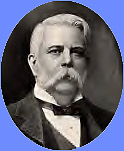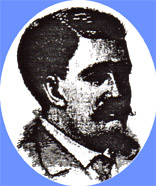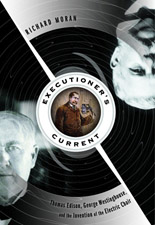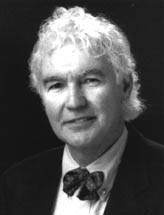|
Appendix B --
One hundred years ago tomorrow, William Kemmler became the first person electrocuted in America. Although the execution itself was terribly botched, supporters proclaimed it a huge success, a triumph of science and humanity over barbarism and brutality. A closer look, however, reveals that the invention of the electric chair was not motivated by a desire to provide the condemned with a quick and painless death, but by the desire of one major electric company to discredit another. In 1882 Thomas Edison launched the "age of electricity" by illuminating the commercial and financial districts of New York City near his Pearl Street power station. Four years later, George Westinghouse, the inventor of the air brake, illuminated Buffalo, New York. Edison lighted New York City with direct current, or DC. Westinghouse employed alternating current, or AC. This simple distinction holds the key to understanding the origin of the electric chair.
Almost immediately, AC became recognized as superior. Unlike DC, which required thick copper wire and frequent power stations, AC could be transmitted over great distances at a relatively low cost. As a result, Edison began to lose market share, and many of his agents deserted to Westinghouse. With sales sagging, Edison and his supporters attacked AC as dangerous, contending that the high voltage required to transmit AC had already caused several accidental deaths. By attempting to associate AC with danger and death, Edison hoped to overcome the inherent advantage of his competitor's product. Enter Harold Brown, the man who invented the electric chair. In June 1888 Brown wrote a letter to the New York Evening Post, outlining the dangers of AC. In it he accused AC manufacturers and distributors of placing their own financial interest ahead of the public welfare. Supporters of AC fought back, contending that Brown was unqualified to make such a determination. Westinghouse himself asserted that alternating current was actually safer than direct current since it entered households at a lower voltage. To prove himself correct, Brown hooked up with Thomas Edison. At Edison's Orange, N.J. laboratory, Brown conducted experiments that demonstrated that less than 800 volts of AC would kill a dog while the same animal could survive 1,000 volts of DC. Soon after, Brown initiated a public campaign to ban alternating current of more than 300 volts. Before an audience of professional electricians and journalists at Columbia College School of Mines, Brown electrocuted a 76-pound dog. Afterward, he proclaimed that alternating current was suitable only for the "dog pound, the slaughterhouse, or the state prison."
Meanwhile, New York State had formed a commission to inquire into the best method of executing condemned criminals. Several particularly gruesome hangings had convinced death penalty advocates that a more reliable and less painful method of executing criminals was needed if the public were to continue its support of capital punishment. Thomas Edison's appearance before the commission proved pivotal. The legendary inventor convinced commissioners that death by electricity was quick and painless, provided, of course, that alternating current was used. Ironically, given the present debate over methods, of executions, death by lethal injection might have been the first choice of the commission, had it not been for the vehement opposition of the medical profession. On June 4, 1888, New York State legalized death by electricity. The Medico-Legal Society was charged with the responsibility of working out the technical details. They engaged the services of Harold Brown. After further experiments on animals at the Edison laboratories, Brown recommended 300 volts of alternating current of 15 to 30 seconds. The commission accepted his recommendation although it asked Dr. George Fell of Buffalo to redesign Brown’s electric chair. Alternating Current would soon be known as the executioner's current. Brown had achieved his goal George Westinghouse was not pleased. He attacked the scientific validity of Brown's killing experiments and pointed out that Brown was employed by Thomas Edison to scare the public into thinking that AC was too dangerous for commercial or residential use. Brown responded by publicly challenging Westinghouse to a duel. In a New York Times advertisement, Brown proposed that each man be hooked up to his respective electrical currents and that the voltage be turned up until one of them cried out that he had had enough. Needless to say, George Westinghouse declined the invitation.
Despite the rancorous controversy involving Brown, the superintendent of prisons for New York authorized him to supply and install the electrocution apparatus. As you might imagine, Westinghouse refused to sell Brown his powerful generators. But Brown remained determined to associate the Westinghouse name with death by electricity. Once again, with Edison working behind the scenes, Brown was able to get the Thomson Houston Electric Co., a competitor of the Westinghouse Electric Co. to launder three generators through a used-dynamo, dealer in Boston. On May 13,1889, the day after the Westinghouse generators arrived at Auburn prison, William Kemmler, "a brute who chopped a woman to bits with an axe" was sentenced to death by electrocution. Doubts about death by electricity surfaced immediately. Lawyers for Kemmler, paid for by Westinghouse, appealed to New York State, contending that electrocution was cruel and unusual punishment, prohibited by the state constitution. A hearing was held in which Edison, while contending to be against capital punishment, assured the court that death by alternating current was quick and painless. Upon cross-examination, both Edison and Brown boldly denied that their support for electrocution by AC had anything to do with their financial interest in the success of DC. Kemmler’s motion was denied, as was a similar petition to the US Supreme Court. On Aug. 6, 1890, William Kemmler became the first man to die in the electric chair. When Kemmler entered the death chamber at 6:30 a.m., he was calm. He instructed the guards not to hurry and told the warden to "take your time and do it right." Later, he asked that the electrode attached to his head be tightened. For the sake of the 25 assembled witnesses, a leather mask was placed over his head. At 6:40 a.m., William Kemmler received two applications of 1,300 volts of alternating current. The first lasted for only 17 seconds because a leather belt was about to fall off one of the second-hand Westinghouse generators. Kemmler was still alive. The second jolt lasted until the smell of burning flesh filled the room, about four minutes. As soon as his charred body stopped smoldering, Kemmler was pronounced dead. Edison must have bribed a journalist because the headline in a morning paper read: "Kemmler Westinghoused." | ||||||||||||||






